Lunar Eclipses
🌞 🌎 🌕
During a lunar eclipse, Earth gets in the way of the sun’s light hitting the moon. That means that during the night, a full moon fades away as Earth’s shadow covers it up.
The moon can also look reddish because Earth’s atmosphere absorbs the other colors while it bends some sunlight toward the moon.
Sunlight bending through the atmosphere and absorbing other colors is also why sunsets are orange and red. During a total lunar eclipse, the moon is shining from all the sunrises and sunsets occurring on Earth!
NASA TV provided coverage of Super Blue Moon Lunar Eclipse on January 31, 2019. The full moon was the third in a series of “supermoons,” when the Moon is closer to Earth in its orbit — known as perigee — and about 14 percent brighter than usual. It was also the second full moon of the month, commonly known as a “blue moon.” As the super blue moon passed through Earth’s shadow, viewers in some locations experienced a total lunar eclipse. While in Earth’s shadow, the moon also took on a reddish tint – which is sometimes referred to as a “blood moon.”
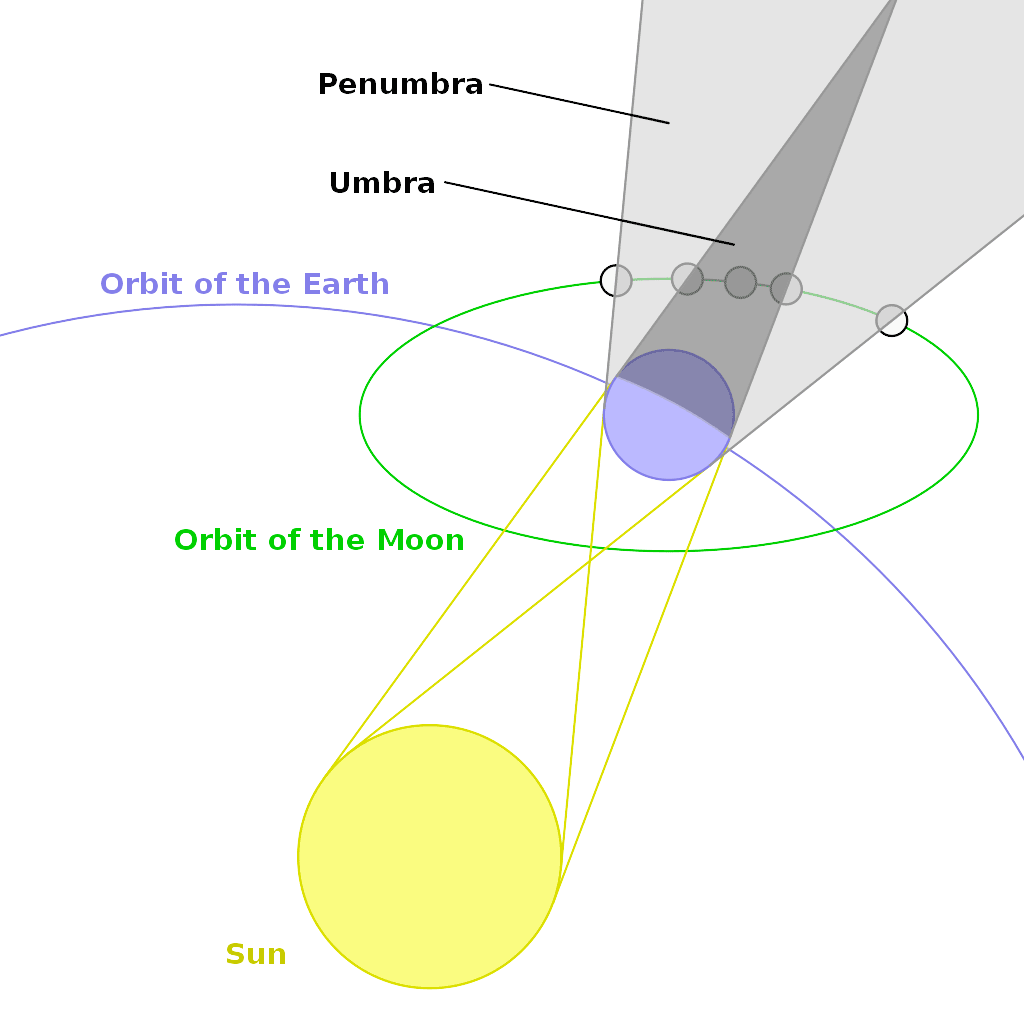
Earth’s shadow can be divided into two distinctive parts: the umbra and penumbra.
Earth totally occludes direct solar radiation within the umbra, the central region of the shadow. However, since the Sun’s diameter appears about one-quarter of Earth’s in the lunar sky, the planet only partially blocks direct sunlight within the penumbra, the outer portion of the shadow.
Within the umbra, the central region, the planet totally shields direct sunlight. In contrast, within the penumbra, the outer portion, the sunlight is only partially blocked.
In the diagram, the Sun, Moon, and Earth sizes nor the distances between the bodies are to scale.
You won’t need any special glasses to see a partial lunar eclipse, unlike when viewing a solar eclipse. Just go outside and look up!
Learn more about some recent lunar eclipses…

Credit: Rice Space Institute
TYPES OF LUNAR ECLIPSES
A lunar eclipse happens when the Sun, Earth, and Full Moon form a near-perfect lineup in space.
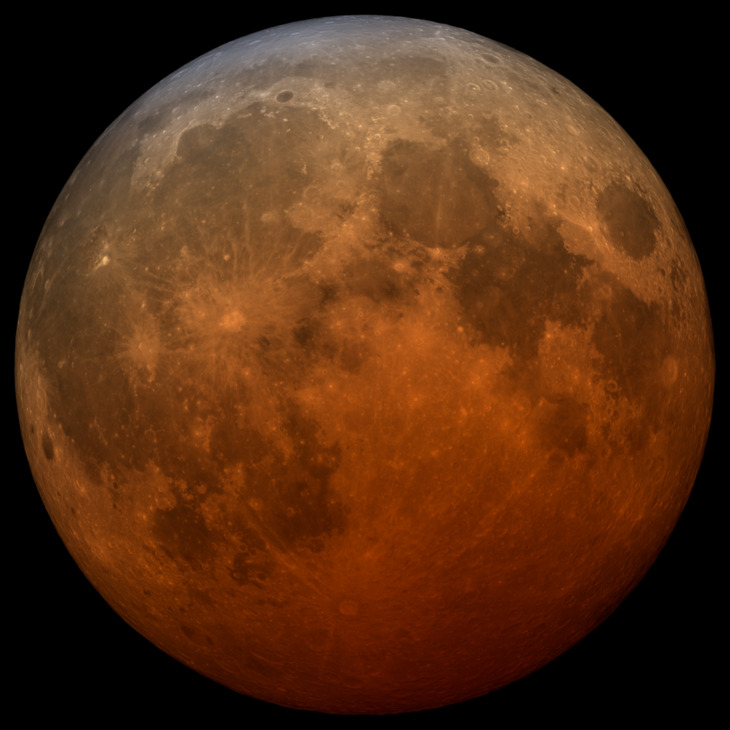
A telescopic visualization of the 2021 total lunar eclipse.
Credit: NASA’s Scientific Visualization Studio
Total Lunar Eclipse
This occurs when the moon falls entirely within the earth’s umbra. Just prior to complete entry, the brightness of the lunar limb– the curved edge of the moon still being hit by direct sunlight– will cause the rest of the moon to appear comparatively dim. The moment the moon enters a complete eclipse, the entire surface will become more or less uniformly bright.
Later, as the moon’s opposite limb is struck by sunlight, the overall disk will again become obscured. This is because as viewed from the Earth, the brightness of a lunar limb is generally greater than that of the rest of the surface due to reflections from the many surface irregularities within the limb: sunlight striking these irregularities is always reflected back in greater quantities than that striking more central parts, and is why the edges of full moons generally appear brighter than the rest of the lunar surface. This is similar to the effect of velvet fabric over a convex curved surface which to an observer will appear darkest at the center of the curve. It will be true of any planetary body with little or no atmosphere and an irregular cratered surface (e.g., Mercury) when viewed opposite the Sun.
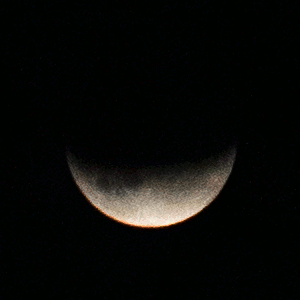
Latter phases of the partial lunar eclipse on 17 July 2019 taken from Gloucestershire, United Kingdom – Credit: Caroline Grubb
Partial Lunar Eclipse
A partial lunar eclipse occurs when only a portion of the Moon passes through the Earth’s darkest shadow. During this type of eclipse, a part of the Moon will darken to a dim orange or red as it moves through the Earth’s shadow.
A partial lunar eclipse occurs when only a portion of the Moon enters Earth’s umbra, while a total lunar eclipse occurs when the entire Moon enters the planet’s umbra. The Moon’s average orbital speed is about 1.03 km/s (2,300 mph), or a little more than its diameter per hour, so totality may last up to nearly 107 minutes. Nevertheless, the total time between the first and the last contacts of the Moon’s limb with Earth’s shadow is much longer and could last up to 236 minutes.
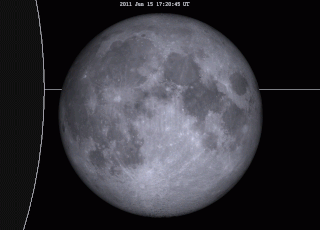
June 15, 2011 – Central Lunar Eclipse
Credit: Attribution: Tomruen at en.wikipedia
Central Lunar Eclipse
This is a total lunar eclipse during which the Moon passes through the center of Earth’s shadow, contacting the antisolar point. This type of lunar eclipse is relatively rare.
The relative distance of the Moon from Earth at the time of an eclipse can affect the eclipse’s duration. In particular, when the Moon is near apogee, the farthest point from Earth in its orbit, its orbital speed is the slowest. The diameter of Earth’s umbra does not decrease appreciably within the changes in the Moon’s orbital distance. Thus, the concurrence of a totally eclipsed Moon near apogee will lengthen the duration of totality.
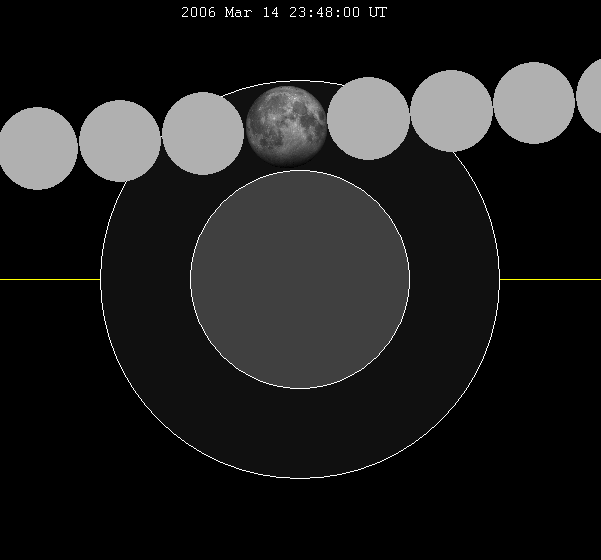
Penumbral Lunar Eclipse
This occurs when the Moon passes through Earth’s penumbra. The penumbra causes a subtle dimming of the lunar surface, which is only visible to the naked eye when about 70% of the Moon’s diameter has been immersed into Earth’s penumbra. A special type of penumbral eclipse is a total penumbral lunar eclipse, during which the Moon lies exclusively within Earth’s penumbra. Total penumbral eclipses are rare, and when these occur, the portion of the Moon closest to the umbra may appear slightly darker than the rest of the lunar disk.
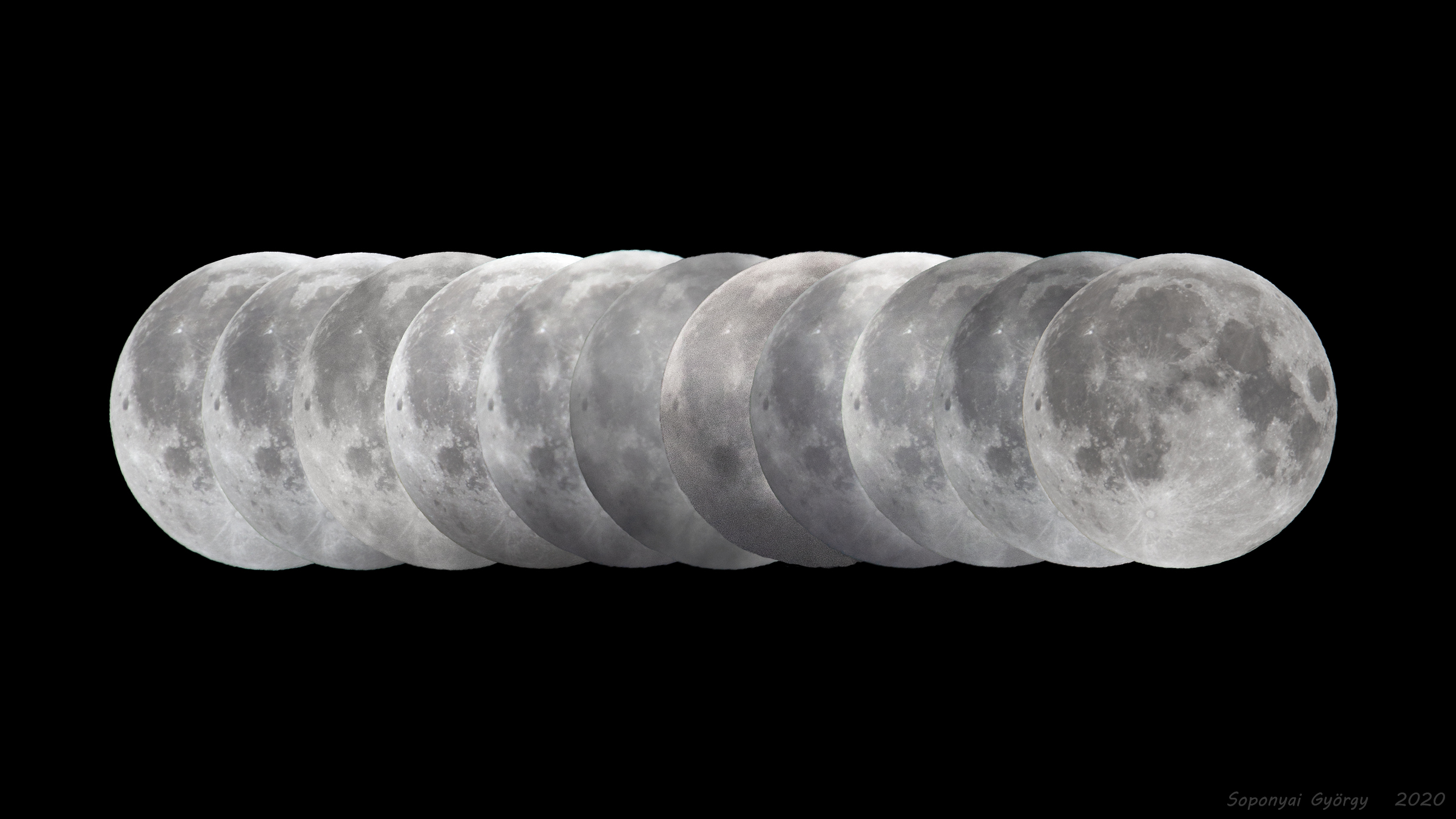
Penumbral Lunar Eclipse – Image Credit & Copyright: Gyorgy Soponyai via Astronomy Picture of the Day (APOD) and Flickr
An Almost Eclipse of the Moon – This composited series of images follows the Moon on January 10, the first Full Moon of 2020, in Hungarian skies. The lunar disk is in mid-eclipse at the center of the sequence though. It looks only slightly darker there as it passes through the light outer shadow or penumbra of planet Earth. In fact during this penumbral lunar eclipse the Moon almost crossed into the northern edge of Earth’s dark central shadow or umbra. Subtle and hard to see, this penumbral lunar eclipse was the first of four lunar eclipses in 2020, all of which will be penumbral lunar eclipses.
SOURCES: NASA, Astronomy Picture of the Day (APOD), Wikipedia
A composite of seven images shows the full moon at perigee, or supermoon, during a total lunar eclipse on Sunday, Sept. 27, 2015, in Denver. Photo Credit: NASA/Bill Ingalls •
Video Credit: NASA
IT’S ALL ABOUT THE MOON
Video Credits: NASA Goddard Space Flight Center
Video Credits: Bray Falls, EarthCapture by @astrofalls / BBC Earth
VIEW THE GALLERY!
Click on an image below to view larger.
Lunar Eclipse Infographic from www.timeanddate.com/eclipse
Featured Total Lunar Eclipse
🌞 🌎 🌕
November 8, 2022 • 08:02:15 UTC • 3:02 am EST
Visible in the Asia, Australia, North America, parts of northern & eastern Europe, and most of South America
The last lunar eclipse was a “Blood Moon”! The Moon appeared red during totality. The total duration was 3 hours, 46 minutes, but the time visible varied by your location. The next total lunar eclipse is in 2 years, 4 months, 5 days, on March 13–14, 2025!
Image Credit: NASA


